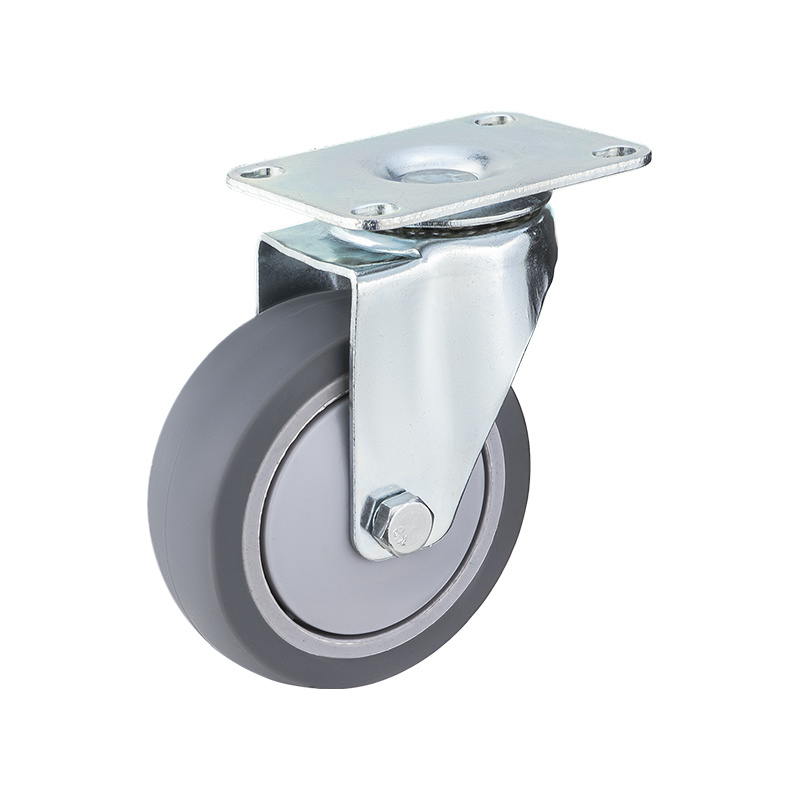BLOG
Examining the Impact of Industrial Trolley Casters on Safety Standards
2025-04-12
Examining the Impact of Industrial Trolley Casters on Safety Standards
Table of Contents
1. Introduction to Industrial Trolley Casters
2. Importance of Safety Standards in Industrial Settings
3. Types of Industrial Trolley Casters
4. Load Capacity and Materials Used in Casters
5. Maintenance and Inspection of Trolley Casters
6. Regulatory Standards Governing Caster Use
7. Case Studi
Examining the Impact of Industrial Trolley Casters on Safety Standards
Table of Contents
- 1. Introduction to Industrial Trolley Casters
- 2. Importance of Safety Standards in Industrial Settings
- 3. Types of Industrial Trolley Casters
- 4. Load Capacity and Materials Used in Casters
- 5. Maintenance and Inspection of Trolley Casters
- 6. Regulatory Standards Governing Caster Use
- 7. Case Studies: Impact of Caster Quality on Safety
- 8. Conclusion
- 9. Frequently Asked Questions
1. Introduction to Industrial Trolley Casters
Industrial trolley casters are essential components that contribute significantly to the efficiency and safety of equipment handling in various industries. These wheels, typically mounted on industrial carts or trolleys, facilitate movement and transport of materials and tools. Their design and functionality can greatly influence workplace ergonomics and safety standards.
The significance of casters extends beyond mere mobility; they also play a pivotal role in reducing the risk of accidents in high-traffic industrial environments. As industries evolve, understanding the impact of these casters on safety standards becomes crucial to maintaining a secure working environment.
2. Importance of Safety Standards in Industrial Settings
Safety standards in industrial environments are critical for preventing workplace accidents, ensuring employee health, and maintaining operational efficiency. With heavy machinery and hazardous materials often involved, the risk of injuries such as slips, trips, and falls increases significantly. Implementing stringent safety standards helps mitigate these risks and promotes a culture of safety.
Industrial trolley casters are directly linked to these safety standards. When casters are improperly selected or maintained, they can cause stability issues, leading to potential accidents. Therefore, understanding the interplay between casters and safety protocols is vital for industry stakeholders, including manufacturers, safety officers, and facility managers.
3. Types of Industrial Trolley Casters
There are various types of industrial trolley casters, each designed for specific applications and environments. Understanding these types helps in selecting the right casters for your needs and plays a significant role in safety. Below are some common classifications:
3.1 Rigid Casters
Rigid casters do not swivel, providing direct movement in a straight line. They are ideal for applications where directional changes are minimal and stability is paramount. Using rigid casters enhances safety when transporting heavy loads over long distances.
3.2 Swivel Casters
Swivel casters can rotate 360 degrees, allowing for enhanced maneuverability. While they provide flexibility in movement, they require careful handling to prevent tipping, especially when transporting heavy items. Proper training and awareness can minimize risks associated with their use.
3.3 Locking Casters
Locking casters feature mechanisms that secure the wheel in place, preventing unwanted movement. This is particularly important when loading or unloading heavy materials. Locking casters contribute significantly to safety by keeping equipment stationary during critical operations.
3.4 All-Terrain Casters
Designed for diverse surfaces, all-terrain casters can handle uneven or outdoor environments. Their robust construction and specialized wheels ensure safety and stability, regardless of the terrain. Using these casters in the right context can reduce the risk of accidents associated with uneven surfaces.
4. Load Capacity and Materials Used in Casters
When selecting industrial trolley casters, understanding load capacity is crucial. Every caster has a specified load limit, which, when exceeded, can compromise safety and performance.
4.1 Determining Load Capacity
Load capacity refers to the maximum weight a caster can safely support. It is essential to consider the total weight of the equipment and its contents. Always choose casters with a higher load capacity than needed to account for unexpected weight fluctuations.
4.2 Materials for Durability and Safety
The materials used in caster construction also significantly impact safety standards. Common materials include:
- **Polyurethane**: Provides excellent floor protection and shock absorption, reducing the risk of slips and falls.
- **Rubber**: Offers good traction and is suitable for indoor environments, enhancing stability.
- **Metal**: Often used in heavy-duty applications, metal casters provide exceptional strength and durability.
Choosing the right material based on the working environment and load requirements is essential for ensuring safety.
5. Maintenance and Inspection of Trolley Casters
Regular maintenance and inspection of industrial trolley casters are critical for sustaining safety standards. Neglecting these practices can lead to equipment failure and accidents.
5.1 Routine Inspections
Establishing a routine inspection schedule helps identify wear and tear before they escalate into safety hazards. Look for signs of damage, such as cracks, excessive wear on wheels, or malfunctioning locking mechanisms.
5.2 Lubrication and Cleaning
Proper lubrication reduces friction and wear, extending the lifespan of casters. Regular cleaning prevents debris buildup, which can hinder performance and safety.
5.3 Replacement Guidelines
Knowing when to replace casters is vital for maintaining safety. If a caster shows significant wear or damage, it should be replaced immediately to avoid potential accidents.
6. Regulatory Standards Governing Caster Use
Various regulatory bodies establish safety standards governing the use of industrial trolley casters. Understanding these regulations helps organizations comply and ensure workplace safety.
6.1 OSHA Regulations
The Occupational Safety and Health Administration (OSHA) outlines essential safety protocols relevant to industrial equipment, including casters. Adhering to OSHA standards helps businesses minimize risks and protect employees.
6.2 ANSI/ISEA Standards
The American National Standards Institute (ANSI) and the International Safety Equipment Association (ISEA) provide guidelines for selecting and using industrial equipment, including casters. Following these standards ensures that organizations maintain high safety levels.
7. Case Studies: Impact of Caster Quality on Safety
Examining real-world case studies offers insight into how caster quality directly affects safety standards in industrial settings.
7.1 Manufacturing Facility Case Study
In a manufacturing facility, the replacement of standard casters with high-quality locking casters significantly reduced incidents of equipment movement during loading. This change enhanced overall safety and worker confidence.
7.2 Warehouse Operations Case Study
A warehouse that implemented a maintenance program for its casters reported a 50% decrease in accidents related to trolley use. Regular inspections and timely replacements proved vital in maintaining safety standards.
8. Conclusion
Industrial trolley casters play a pivotal role in ensuring safety standards within various industries. By understanding the types, load capacities, materials, maintenance practices, and regulatory frameworks associated with casters, organizations can greatly enhance workplace safety. Investing in quality casters and adhering to best practices not only protects employees but also boosts operational efficiency. As industries continue to evolve, the importance of prioritizing safety through effective caster management cannot be overstated.
9. Frequently Asked Questions
Q1: What are the primary functions of industrial trolley casters?
A1: Industrial trolley casters facilitate the movement of equipment and materials, enhancing operational efficiency and safety in various settings.
Q2: How do I determine the right load capacity for my casters?
A2: Always calculate the total weight of the equipment and its contents, and select casters with a higher load capacity to accommodate unexpected weight increases.
Q3: What maintenance practices should I employ for my casters?
A3: Regular inspections, lubrication, and cleaning are essential maintenance practices. Replace any damaged or worn casters immediately.
Q4: Are there specific regulatory standards for trolley casters?
A4: Yes, OSHA and ANSI/ISEA provide guidelines and regulations that govern the use of industrial equipment, including casters.
Q5: What materials are best for industrial casters?
A5: Polyurethane, rubber, and metal are commonly used materials that provide various benefits, including durability and floor protection.
This comprehensive exploration of industrial trolley casters and their impact on safety standards aims to empower industry professionals in making informed decisions that prioritize safety and efficiency in their operations.
Key words:
RELATED NEWS
Heavy Duty Caster Trends: What's New in the Market?
2025-05-24
Heavy Duty Caster Trends: What's New in the Market?
Introduction to Heavy Duty Casters
Heavy-duty casters are essential components in various industries, providing mobility and stability for equipment, furniture, and materials. With advancements in technology and design, the heavy-duty caster market is continually evolving. In this article, we will explore the latest trends in heavy-duty casters,
Mastering the Essentials of Industrial Casters for Optimal Performance
2025-05-17
Industrial casters are vital components in various industries, especially in the realm of hardware tools and accessories. Understanding these components can significantly impact your operations, whether you're involved in manufacturing, warehousing, or logistics. This article delves into the essential features, types, and maintenance tips related to industrial casters, aiming to equip you with pra
Understanding Load Ratings: How to Choose Your Medium Duty Caster for Optimal Performance
2025-05-10
Understanding Load Ratings: How to Choose Your Medium Duty Caster for Optimal Performance
Table of Contents
Introduction to Medium Duty Casters
Understanding Load Ratings for Casters
Factors Affecting Load Capacity
Materials and Design Considerations
How to Choose the Right Medium Duty Caster
Applications for Medium Duty Casters
Maintenance and Care for Longevity
F








